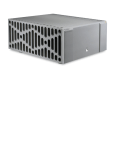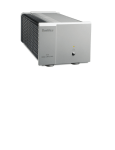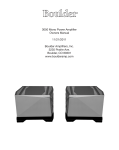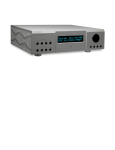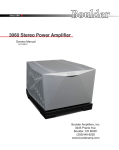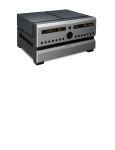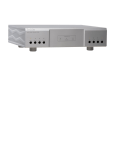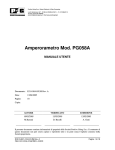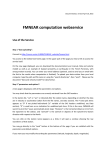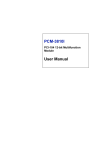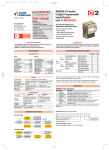Download Boulder 860 Instruction manual
Transcript
Boulder 860 150 Watt Stereo Power Amplifier Instruction Manual 6/13/07 Boulder Amplifiers, Inc. 3235 Prairie Ave. Boulder, CO 80301 www.boulderamp.com APPENDIX BOULDER LINK REMOTE CONTROL OPERATION GETTING STARTED Boulder 860 Stereo Power Amplifier Rear Panel APPENDIX BOULDER LINK REMOTE CONTROL OPERATION GETTING STARTED TABLE OF CONTENTS GETTING STARTED Placement of the 860 Stereo Power Amplifier. . . . . . . . . . . . . . . . . . . . . . . . . . . . . . . . . . . Connecting to the Mains Outlet . . . . . . . . . . . . . . . . . . . . . . . . . . . . . . . . . . . . . . . . . . . . . . Connecting a Balanced Source. . . . . . . . . . . . . . . . . . . . . . . . . . . . . . . . . . . . . . . . . . . . . . . . Connecting an Unbalanced Source . . . . . . . . . . . . . . . . . . . . . . . . . . . . . . . . . . . . . . . . . . . . Polarity . . . . . . . . . . . . . . . . . . . . . . . . . . . . . . . . . . . . . . . . . . . . . . . . . . . . . . . . . . . . . . . . . . . Connecting Your Loudspeakers . . . . . . . . . . . . . . . . . . . . . . . . . . . . . . . . . . . . . . . . . . . . . . OPERATION Powering Up. . . . . . . . . . . . . . . . . . . . . . . . . . . . . . . . . . . . . . . . . . . . . . . . . . . . . . . . . . . . . . . Clip Detection. . . . . . . . . . . . . . . . . . . . . . . . . . . . . . . . . . . . . . . . . . . . . . . . . . . . . . . . . . . . . . Shorted Output Detection . . . . . . . . . . . . . . . . . . . . . . . . . . . . . . . . . . . . . . . . . . . . . . . . . . . Thermal Protection . . . . . . . . . . . . . . . . . . . . . . . . . . . . . . . . . . . . . . . . . . . . . . . . . . . . . . . . . Maintenance . . . . . . . . . . . . . . . . . . . . . . . . . . . . . . . . . . . . . . . . . . . . . . . . . . . . . . . . . . . . . . . REMOTE CONTROL OPERATION Remote Control Operation . . . . . . . . . . . . . . . . . . . . . . . . . . . . . . . . . . . . . . . . . . . . . . . . . . . 12 Volt Trigger . . . . . . . . . . . . . . . . . . . . . . . . . . . . . . . . . . . . . . . . . . . . . . . . . . . . . . . . . . . . . BOULDERLINK Connecting the Boulderlink . . . . . . . . . . . . . . . . . . . . . . . . . . . . . . . . . . . . . . . . . . . . . . . . . . Setting Boulderlink Switches . . . . . . . . . . . . . . . . . . . . . . . . . . . . . . . . . . . . . . . . . . . . . . . . . Setting Boulderlink ID Numbers. . . . . . . . . . . . . . . . . . . . . . . . . . . . . . . . . . . . . . . . . . . . . . Power Up via Boulderlink . . . . . . . . . . . . . . . . . . . . . . . . . . . . . . . . . . . . . . . . . . . . . . . . . . . Boulderlink Messages . . . . . . . . . . . . . . . . . . . . . . . . . . . . . . . . . . . . . . . . . . . . . . . . . . . . . . . APPENDIX BOULDER LINK REMOTE CONTROL OPERATION 1-1 1-2 1-3 1-4 1-5 1-5 2-1 2-2 2-3 2-3 2-3 3-1 3-1 4-1 4-2 4-2 4-3 4-4 GETTING STARTED APPENDIX Specifications . . . . . . . . . . . . . . . . . . . . . . . . . . . . . . . . . . . . . . . . . . . . . . . . . . . . . . . . . . . . . . 5-1 Troubleshooting . . . . . . . . . . . . . . . . . . . . . . . . . . . . . . . . . . . . . . . . . . . . . . . . . . . . . . . . . . . . 5-2 Notes . . . . . . . . . . . . . . . . . . . . . . . . . . . . . . . . . . . . . . . . . . . . . . . . . . . . . . . . . . . . . . . . . . . . . 5-3 APPENDIX BOULDER LINK REMOTE CONTROL OPERATION GETTING STARTED G ETTING STARTED PLACEMENT OF THE 860 STEREO POWER AMPLIFIER Your Boulder 860 Stereo Power Amplifier is designed to reduce interference from external magnetic and radio fields (RF). While placement is not critical, known magnetic fields should be avoided. Because the amplifier is heavy, a solid, stable surface should be used. As the amplifier will generate some heat, there should be good air circulation around it. In particular, make certain that the heat sinks are not blocked. You may want to have some access to the rear panels for cable changes. Boulder recommends that you keep the loudspeaker cables as short as possible and have the interconnect cables as long as necessary. 1-1 GETTING STARTED CONNECTING TO THE MAINS OUTLET Your 860 Stereo Power Amplifier is supplied with a mains cord suitable for the location where it was purchased. It is constructed of a large enough wire gauge and a cable plug appropriate for the voltage you intend to use. Do not substitute another power cable. The voltage appears on the rear panel. If you require a different AC mains voltage, contact your dealer immediately. Exact voltage and frequency compatibility is stated in the specifications section. Once the 860 Stereo Power Amplifier is connected to a live mains outlet and the mains power switch turned on, the front panel indicator will be illuminated. The indicator will be of varying color, showing that the supervising microprocessor is powered up and ready. 1-2 GETTING STARTED CONNECTING A BALANCED SOURCE To fully realize the sonic potential of your 860 Stereo Power Amplifier, use balanced connections whenever possible. Balanced cables reduce interference from magnetic and RF sources to an absolute minimum. Connect your preamplifier or source outputs to the inputs provided. 1-3 GETTING STARTED CONNECTING AN UNBALANCED SOURCE Although the input connectors are of the three-pin XLR type, an unbalanced source is easily accommodated by using a special cable. This cable has an RCA phono type connector on the source end and a threepin XLR connector to go to the input of the 860 Stereo Power Amplifier. The negative input (Pin 3) should be wired to ground only at the RCA phono connector. This brings the negative input reference of the 860 to the unbalanced source ground, thus reducing ground loops. Another option for accommodating unbalanced sources is to use Boulder ABL2 Input Adapters. They convert a balanced input into an unbalanced RCA phono input right at the rear of the 860. Like the above cable, the negative input of the 860 is connected to the ground of the RCA connector. However, the negative side will then share the shield wire with the chassis ground and will not have very good hum rejection. UNBALANCED INPUT CABLE 2-POS INPUT 3-NEG INPUT 1-GROUND 1-4 GETTING STARTED POLARITY Please note that the 860 Stereo Power Amplifier conforms to the standard of Pin 2 as the high or ”hot” for the balanced inputs. The polarity of the 860 Stereo Power Amplifier is such that a positivegoing transition at Pin 2 will produce a positive-going transition at the “+” output terminal. CONNECTING YOUR LOUDSPEAKERS Do not use any wrenches on the loudspeaker binding posts! Tighten these connectors only by hand. WARNING: This is a high power amplifier! When driven, there is a high voltage potential at the terminals. Connections should only be made with the AC mains disconnected! Select spade terminals which accept 6 mm or .250 inch diameter binding posts. There is no provision for the use of banana plugs. These plugs have been proven to come loose over time which increases contact resistance and distortion. For the same reason we also do NOT recommend the use of banana plugs at the loudspeaker end. 1-5 GETTING STARTED O PERATION POWERING UP With all your connections made, you are ready to listen to your Boulder 860 Stereo Power Amplifier. To turn the amplifier on, press the STANDBY button on the front panel. The amplifier will perform a warm up cycle and the indicator will alternate between red and amber for 45 seconds. This power up sequence can be skipped by pressing and holding the STANDBY button until the indicator turns red; then release and it will start in about five seconds. To reduce the inrush of electrical current during power-up, relays are used to turn on the amplifier in stages. These are under the control of the supervising microprocessor. During the power up sequence, you will hear a relay click followed by an additional relay click after two seconds. The indicator will then turn and remain amber during normal operation. To turn the amplifier off, press the STANDBY button again. The indicator will continuously change from red to green. 2-1 OPERATION CLIP DETECTION Clipping of the waveform results when any amplifier is driven at too high a level. A clip detection circuit is included in the 860 Stereo Power Amplifier. The indicator will indicate clipping by momentarily turning from amber to red. Both voltage and current modes of clipping will be detected, although generally it is only voltage clipping which occurs. 2-2 OPERATION SHORTED OUTPUT DETECTION If the output of the amplifier becomes shorted, the front panel indicator will turn red and the amplifier will turn off the output stage for about three seconds, then very briefly try to turn on again. If the short still exists, this cycle will repeat until the short circuit is removed. THERMAL PROTECTION A thermal protection circuit prevents high case temperatures which are unpleasant to the touch and potentially harmful to the amplifier. The thermal cutout circuit will mute the amplifier when the transistor cases reach 85°C, and the indicator will turn red. If this happens, more ventilation should be provided for the amplifiers. MAINTENANCE No routine maintenance is required for the Boulder 860 Stereo Power Amplifier. However, to keep operating temperatures at a minimum, do not block the heat sinks, and remove any dust buildup that may occur. 2-3 OPERATION R EMOTE CONTROL OPERATION Operation of the Boulder 860 Stereo Power Amplifier by remote control is possible when connected by a Boulderlink cable to other Boulder preamplifiers or CD players. When so connected, the 860 Stereo Power Amplifier will be turned on and off with the other component. 12 VOLT TRIGGER The 860 Stereo Power Amplifier also provides a trigger input for remote on/off operation with other brands of equipment. With a trigger connection, the 860 will be on when the voltage is +5 to +12 volts, and off when the voltage is 0 volts. The tip of the mini phone plug should be positive with respect to the sleeve. When the 12 Volt Trigger is used, the 860 Stereo Power Amplifier will be turned on in the sequence set by the ID switch. See page 4-2. WARNING: Boulderlink and the trigger input should never be used at the same time. 3-1 REMOTE CONTROL B OULDERLINK BOULDERLINK "DAISY CHAIN" BOULDER PREAMPLIFIER BOULDER POWER AMPLIFIER BOULDER POWER AMPLIFIER MASTER SLAVE SLAVE TO ALL OTHER SLAVE UNITS Boulderlink is a means of interconnecting most Boulder products so that their microprocessors can talk to each other and pass important information. Among the key features, Boulderlink allows sequential initiation of power amplifiers’ and other products’ power up when the ”master” component is turned on. Boulder power amplifiers can send messages to certain other Boulder products which are then shown on the display. CONNECTING BOULDERLINK Turn off all products to be linked before connecting any Boulderlink cables and setting the Boulderlink ID and Master/Slave switches. Two connectors are provided on the back of the 860 and other Boulderlink enabled products. Boulderlink cables in various lengths are available as an accessory from your Boulder dealer. All the chassis are connected together in a daisy chain manner. Start by connecting one chassis to another, then from that chassis to the next until all are connected. The order does not matter. A special interface may be obtained to enable Boulderlink to be used with other automation and control systems. Contact your Boulder dealer for details. 4-1 BOULDER LINK SETTING BOULDERLINK SWITCHES Every Boulderlink system must have one “MASTER” component, and only one component can be set to MASTER. This is usually the preamplifier. Power amplifiers and other products not having a MASTER/SLAVE switch are not eligible to be “MASTER.” SETTING BOULDERLINK ID NUMBERS Every component is required to have a unique Boulderlink ID number. Each Boulder 860 Stereo Power Amplifier has a thumbwheel switch on the rear panel. Start by setting the switch on the first amplifier to 0 or 1 and then increment up from there without any duplication. Use of the lowest numbers will speed up turn-on as each amplifier is allowed about three seconds before the next. This spreads out the power line inrush currents thus preventing house circuit breakers from unnecessary tripping. Up to 16 power amplifiers may be connected together in one Boulderlink cable daisy chain. 4-2 BOULDER LINK POWER UP VIA BOULDERLINK With each component connected together by a Boulderlink cable, and individually connected to the mains, pressing the master’s STANDBY pushbutton will initiate the turn on sequence of all components. The first time a master is powered up, it will search for any “slave” units connected to it. As the master finds each slave, the slave’s ID number will be shown on the display. If any of the connected slaves are amplifiers, then each time the master is turned on it will display “WAITING FOR AMPS.” Each amplifier will be turned on in the order of their Boulderlink ID. To minimize turn on time, the amplifier Boulderlink IDs should be set to the lowest sequential numbers possible. For example, use 0, 1, and 2 instead of 13 , 14, and 15. An amplifier set to ID 15 will take 47 seconds to turn on. 4-3 BOULDER LINK BOULDERLINK MESSAGES Each component in the system can send a message to the preamplifier which is then shown on its display. This is particularly helpful in confirming the operating status of each power amplifier in a multiple amplifier system. Typical messages on an 810 Preamplifier, 1010 Preamplifier or 1012 DAC Preamplifier are as follows. “AMPLIFIER 1 ERROR” means that an internal power supply has failed and the amplifier has turned itself off to protect the speakers from damage. “AMPLIFIER 1 IS HOT” means that is has turned itself off due to a higher than normal temperature condition on the heatsinks. “AMPLIFIER CLIP” means that the amplifier’s output has momentarily reached its voltage limitation. “UNIT 1 IS OFFLINE” means that the slave is no longer responding via Boulderlink. Its Boulderlink cable may have become disconnected, or the mains power has been disconnected. “UNIT 1 IS ONLINE” means that the slave is now responding via Boulderlink in a normal manner and has been recognized by the master. 4-4 BOULDER LINK BOU L D E R 8 6 0 S T E R E O P O W ER AMPLIFIER SPECIFICATIONS THD at Continuous Power, 20 to 2KHz THD at Continuous Power, at 20KHz Continuous Power, 8 Ω Continuous Power, 4 Ω Peak Power, 8 Ω Peak Power, 4 Ω Magnitude Response, 20 to 20KHz Magnitude Response, -3 dB at Voltage Gain Signal to Noise Ratio (re: 500W/8Ω) Input Impedance Common Mode Rejection (Balanced only) Inputs Output Connectors Crosstalk, L to R or R to L Size, Inches, Width X Height X Depth Power Requirements All specifications taken at 120 VAC mains power 5-1 APPENDIX 0.0035% 0.018% 150W 150W 150 W 300 W +0.00, -0.04 dB 0.015Hz, 150kHz 26dB -108dB, unweighted, 20 to 22kHz Balanced: 50KΩ, Unbalanced: 25KΩ 60Hz: 90dB, 10kHz: 70dB 3-pin Balanced 6 mm / .250 inch thumbscrews Greater than 112dB 17.0W x 7.38H x 15.25D Speaker connectors add 1.50 to depth Voltage suitable for country where sold 50-60 Hz, 850 W at maximum TROUBLESHOOTING SYMPTOM No power indication Red power indication Amber power indication, but sound not heard from one channel 5-2 APPENDIX CAUSE REMEDY Power switch is not on Turn on rear panel power switch Power amplifier is not plugged in Connect to an AC outlet Home circuit breaker is tripped Reset circuit breaker Fuse on rear panel blown Replace fuse Low line voltage Have line voltage checked Power supply breaker tripped Reset breakers on rear panel Defective amplifier Return to dealer for service No signal from one channel of source Check source controls, cables, and connections One channel is muted by balance control Recenter balance on preamp No signal out to power amplifier Check connections to power amp NOTES 5-3 APPENDIX





















